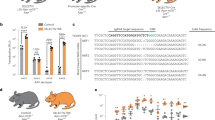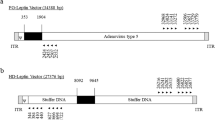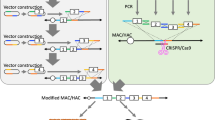Abstract
We previously demonstrated that systemic administration of adenovirus serotype 35 (Ad35) vectors to mice does not mediate efficient transduction in organs, probably because expression of the mouse analog of the subgroup B Ad receptor, human CD46 (membrane cofactor protein), is limited to the testis. Here, we describe the in vitro and in vivo transduction characteristics of Ad35 vectors by using homozygous and hemizygous human CD46-transgenic (CD46TG) mice, which ubiquitously express human CD46. An Ad35 vector more efficiently transduced the primary dendritic cells and macrophages prepared from CD46TG mice than those from wild-type mice. In vivo transduction experiments demonstrated that CD46TG mice are more susceptible to Ad35 vector-mediated in vivo transduction than are wild-type mice. In particular, homozygous CD46TG mice, which express higher levels of CD46 in the organs than hemizygous CD46TG mice, tend to exhibit higher transduction efficiencies after intraperitoneal administration than hemizygous CD46TG mice. Intraperitoneal administration of Ad35 vectors resulted in efficient transduction into the mesothelial cells of the peritoneal organs in homozygous CD46TG mice. These results indicate that an Ad35 vector recognizes human CD46 as a cellular receptor in CD46TG mice. However, the in vivo transduction efficiencies of Ad35 vectors in CD46TG mice are much lower than those of conventional Ad5 vectors in wild-type mice.
This is a preview of subscription content, access via your institution
Access options
Subscribe to this journal
Receive 12 print issues and online access
$259.00 per year
only $21.58 per issue
Buy this article
- Purchase on Springer Link
- Instant access to full article PDF
Prices may be subject to local taxes which are calculated during checkout






Similar content being viewed by others
References
Havenga MJ, Lemckert AA, Ophorst OJ, van Meijer M, Germeraad WT, Grimbergen J et al. Exploiting the natural diversity in adenovirus tropism for therapy and prevention of disease. J Virol 2002; 76: 4612–4620.
De Jong JC, Wermenbol AG, Verweij-Uijterwaal MW, Slaterus KW, Wertheim-Van Dillen P, Van Doornum GJ et al. Adenoviruses from human immunodeficiency virus-infected individuals, including two strains that represent new candidate serotypes Ad50 and Ad51 of species B1 and D, respectively. J Clin Microbiol 1999; 37: 3940–3945.
Chirmule N, Propert K, Magosin S, Qian Y, Qian R, Wilson J . Immune responses to adenovirus and adeno-associated virus in humans. Gene Therapy 1999; 6: 1574–1583.
Stone D, Ni S, Li ZY, Gaggar A, DiPaolo N, Feng Q et al. Development and assessment of human adenovirus type 11 as a gene transfer vector. J Virol 2005; 79: 5090–5104.
Smith TA, White BD, Gardner JM, Kaleko M, McClelland A . Transient immunosuppression permits successful repetitive intravenous administration of an adenovirus vector. Gene Therapy 1996; 3: 496–502.
Vlachaki MT, Hernandez-Garcia A, Ittmann M, Chhikara M, Aguilar LK, Zhu X et al. Impact of preimmunization on adenoviral vector expression and toxicity in a subcutaneous mouse cancer model. Mol Ther 2002; 6: 342–348.
Rebel VI, Hartnett S, Denham J, Chan M, Finberg R, Sieff CA . Maturation and lineage-specific expression of the coxsackie and adenovirus receptor in hematopoietic cells. Stem Cells 2000; 18: 176–182.
Tillman BW, de Gruijl TD, Luykx-de Bakker SA, Scheper RJ, Pinedo HM, Curiel TJ et al. Maturation of dendritic cells accompanies high-efficiency gene transfer by a CD40-targeted adenoviral vector. J Immunol 1999; 162: 6378–6383.
Haviv YS, Blackwell JL, Kanerva A, Nagi P, Krasnykh V, Dmitriev I et al. Adenoviral gene therapy for renal cancer requires retargeting to alternative cellular receptors. Cancer Res 2002; 62: 4273–4281.
Abrahamsen K, Kong HL, Mastrangeli A, Brough D, Lizonova A, Crystal RG et al. Construction of an adenovirus type 7a E1A- vector. J Virol 1997; 71: 8946–8951.
Holterman L, Vogels R, van der Vlugt R, Sieuwerts M, Grimbergen J, Kaspers J et al. Novel replication-incompetent vector derived from adenovirus type 11 (Ad11) for vaccination and gene therapy: low seroprevalence and non-cross-reactivity with Ad5. J Virol 2004; 78: 13207–13215.
Sakurai F, Mizuguchi H, Hayakawa T . Efficient gene transfer into human CD34+ cells by an adenovirus type 35 vector. Gene Therapy 2003; 10: 1041–1048.
Sakurai F, Mizuguchi H, Yamaguchi T, Hayakawa T . Characterization of in vitro and in vivo gene transfer properties of adenovirus serotype 35 vector. Mol Ther 2003; 8: 813–821.
Vogels R, Zuijdgeest D, van Rijnsoever R, Hartkoorn E, Damen I, de Bethune MP et al. Replication-deficient human adenovirus type 35 vectors for gene transfer and vaccination: efficient human cell infection and bypass of preexisting adenovirus immunity. J Virol 2003; 77: 8263–8271.
Seshidhar Reddy P, Ganesh S, Limbach MP, Brann T, Pinkstaff A, Kaloss M et al. Development of adenovirus serotype 35 as a gene transfer vector. Virology 2003; 311: 384–393.
Farina SF, Gao GP, Xiang ZQ, Rux JJ, Burnett RM, Alvira MR et al. Replication-defective vector based on a chimpanzee adenovirus. J Virol 2001; 75: 11603–11613.
Reddy PS, Idamakanti N, Chen Y, Whale T, Babiuk LA, Mehtali M et al. Replication-defective bovine adenovirus type 3 as an expression vector. J Virol 1999; 73: 9137–9144.
Nguyen T, Nery J, Joseph S, Rocha C, Carney G, Spindler K et al. Mouse adenovirus (MAV-1) expression in primary human endothelial cells and generation of a full-length infectious plasmid. Gene Therapy 1999; 6: 1291–1297.
Hofmann C, Loser P, Cichon G, Arnold W, Both GW, Strauss M . Ovine adenovirus vectors overcome preexisting humoral immunity against human adenoviruses in vivo. J Virol 1999; 73: 6930–6936.
Gaggar A, Shayakhmetov DM, Lieber A . CD46 is a cellular receptor for group B adenoviruses. Nat Med 2003; 9: 1408–1412.
Segerman A, Atkinson JP, Marttila M, Dennerquist V, Wadell G, Arnberg N . Adenovirus type 11 uses CD46 as a cellular receptor. J Virol 2003; 77: 9183–9191.
Sakurai F, Kawabata K, Yamaguchi T, Hayakawa T, Mizuguchi H . Optimization of adenovirus serotype 35 vectors for efficient transduction in human hematopoietic progenitors: comparison of promoter activities. Gene Therapy 2005; 12: 1424–1433.
Peng KW, TenEyck CJ, Galanis E, Kalli KR, Hartmann LC, Russell SJ . Intraperitoneal therapy of ovarian cancer using an engineered measles virus. Cancer Res 2002; 62: 4656–4662.
Bjorge L, Hakulinen J, Wahlstrom T, Matre R, Meri S . Complement-regulatory proteins in ovarian malignancies. Int J Cancer 1997; 70: 14–25.
Tsujimura A, Shida K, Kitamura M, Nomura M, Takeda J, Tanaka H et al. Molecular cloning of a murine homologue of membrane cofactor protein (CD46): preferential expression in testicular germ cells. Biochem J 1998; 330 (Part 1): 163–168.
Johnstone RW, Loveland BE, McKenzie IF . Identification and quantification of complement regulator CD46 on normal human tissues. Immunology 1993; 79: 341–347.
Kemper C, Leung M, Stephensen CB, Pinkert CA, Liszewski MK, Cattaneo R et al. Membrane cofactor protein (MCP; CD46) expression in transgenic mice. Clin Exp Immunol 2001; 124: 180–189.
Oldstone MB, Lewicki H, Thomas D, Tishon A, Dales S, Patterson J et al. Measles virus infection in a transgenic model: virus-induced immunosuppression and central nervous system disease. Cell 1999; 98: 629–640.
Lemckert AA, Sumida SM, Holterman L, Vogels R, Truitt DM, Lynch DM et al. Immunogenicity of heterologous prime-boost regimens involving recombinant adenovirus serotype 11 (Ad11) and Ad35 vaccine vectors in the presence of anti-ad5 immunity. J Virol 2005; 79: 9694–9701.
Barouch DH, Pau MG, Custers JH, Koudstaal W, Kostense S, Havenga MJ et al. Immunogenicity of recombinant adenovirus serotype 35 vaccine in the presence of pre-existing anti-Ad5 immunity. J Immunol 2004; 172: 6290–6297.
Okada N, Masunaga Y, Okada Y, Iiyama S, Mori N, Tsuda T et al. Gene transduction efficiency and maturation status in mouse bone marrow-derived dendritic cells infected with conventional or RGD fiber-mutant adenovirus vectors. Cancer Gene Ther 2003; 10: 421–431.
Takagi T, Kitano M, Masuda S, Tokuda H, Takakura Y, Hashida M . Augmented inhibitory effect of superoxide dismutase on superoxide anion release from macrophages by direct cationization. Biochim Biophys Acta 1997; 1335: 91–98.
Mizuguchi H, Kay MA . Efficient construction of a recombinant adenovirus vector by an improved in vitro ligation method. Hum Gene Ther 1998; 9: 2577–2583.
Mizuguchi H, Kay MA . A simple method for constructing E1- and E1/E4-deleted recombinant adenoviral vectors. Hum Gene Ther 1999; 10: 2013–2017.
Zubieta C, Schoehn G, Chroboczek J, Cusack S . The structure of the human adenovirus 2 penton. Mol Cell 2005; 17: 121–135.
Mizuguchi H, Koizumi N, Hosono T, Ishii-Watabe A, Uchida E, Utoguchi N et al. CAR- or alphav integrin-binding ablated adenovirus vectors, but not fiber-modified vectors containing RGD peptide, do not change the systemic gene transfer properties in mice. Gene Therapy 2002; 9: 769–776.
Wood M, Perrotte P, Onishi E, Harper ME, Dinney C, Pagliaro L et al. Biodistribution of an adenoviral vector carrying the luciferase reporter gene following intravesical or intravenous administration to a mouse. Cancer Gene Ther 1999; 6: 367–372.
Huard J, Lochmuller H, Acsadi G, Jani A, Massie B, Karpati G . The route of administration is a major determinant of the transduction efficiency of rat tissues by adenoviral recombinants. Gene Therapy 1995; 2: 107–115.
Cattaneo R . Four viruses, two bacteria, and one receptor: membrane cofactor protein (CD46) as pathogens' magnet. J Virol 2004; 78: 4385–4388.
Mrkic B, Pavlovic J, Rulicke T, Volpe P, Buchholz CJ, Hourcade D et al. Measles virus spread and pathogenesis in genetically modified mice. J Virol 1998; 72: 7420–7427.
Johansson L, Rytkonen A, Bergman P, Albiger B, Kallstrom H, Hokfelt T et al. CD46 in meningococcal disease. Science 2003; 301: 373–375.
Maisner A, Zimmer G, Liszewski MK, Lublin DM, Atkinson JP, Herrler G . Membrane cofactor protein (CD46) is a basolateral protein that is not endocytosed. Importance of the tetrapeptide FTSL at the carboxyl terminus. J Biol Chem 1997; 272: 20793–20799.
Ichida S, Yuzawa Y, Okada H, Yoshioka K, Matsuo S . Localization of the complement regulatory proteins in the normal human kidney. Kidney Int 1994; 46: 89–96.
Sinn PL, Williams G, Vongpunsawad S, Cattaneo R, McCray Jr PB . Measles virus preferentially transduces the basolateral surface of well-differentiated human airway epithelia. J Virol 2002; 76: 2403–2409.
Segerman A, Arnberg N, Erikson A, Lindman K, Wadell G . There are two different species B adenovirus receptors: sBAR, common to species B1 and B2 adenoviruses, and sB2AR, exclusively used by species B2 adenoviruses. J Virol 2003; 77: 1157–1162.
Seya T, Hara T, Iwata K, Kuriyama S, Hasegawa T, Nagase Y et al. Purification and functional properties of soluble forms of membrane cofactor protein (CD46) of complement: identification of forms increased in cancer patients' sera. Int Immunol 1995; 7: 727–736.
Smith TA, Idamakanti N, Rollence ML, Marshall-Neff J, Kim J, Mulgrew K et al. Adenovirus serotype 5 fiber shaft influences in vivo gene transfer in mice. Hum Gene Ther 2003; 14: 777–787.
Koizumi N, Mizuguchi H, Sakurai F, Yamaguchi T, Watanabe Y, Hayakawa T . Reduction of natural adenovirus tropism to mouse liver by fiber-shaft exchange in combination with both CAR- and alphav integrin-binding ablation. J Virol 2003; 77: 13062–13072.
Anderson BD, Nakamura T, Russell SJ, Peng KW . High CD46 receptor density determines preferential killing of tumor cells by oncolytic measles virus. Cancer Res 2004; 64: 4919–4926.
Kimura Y, Yanagimachi R . Intracytoplasmic sperm injection in the mouse. Biol Reprod 1995; 52: 709–720.
Perry AC, Wakayama T, Kishikawa H, Kasai T, Okabe M, Toyoda Y et al. Mammalian transgenesis by intracytoplasmic sperm injection. Science 1999; 284: 1180–1183.
Hosono T, Mizuguchi H, Katayama K, Xu ZL, Sakurai F, Ishii-Watabe A et al. Adenovirus vector-mediated doxycycline-inducible RNA interference. Hum Gene Ther 2004; 15: 813–819.
Xu ZL, Mizuguchi H, Ishii-Watabe A, Uchida E, Mayumi T, Hayakawa T . Optimization of transcriptional regulatory elements for constructing plasmid vectors. Gene 2001; 272: 149–156.
Sakai M, Nishikawa M, Thanaketpaisarn O, Yamashita F, Hashida M . Hepatocyte-targeted gene transfer by combination of vascularly delivered plasmid DNA and in vivo electroporation. Gene Therapy 2005; 12: 607–616.
Sakurai F, Nishioka T, Saito H, Baba T, Okuda A, Matsumoto O et al. Interaction between DNA–cationic liposome complexes and erythrocytes is an important factor in systemic gene transfer via the intravenous route in mice: the role of the neutral helper lipid. Gene Therapy 2001; 8: 677–686.
Acknowledgements
We thank Ms Tomomi Sasaki, Ms Tsukasa Nakano and Ms Kimiyo Akitomo for their technical assistance. We also thank Dr Naoki Okada (Kyoto Pharmaceutical University, Kyoto, Japan) for his help in the preparation of bone marrow-derived DCs. This work was supported by grants for Health and Labour Sciences Research from the Ministry of Health, Labour, and Welfare of Japan, and by Grants-in-Aid for Scientific Research on Priority Areas (B).
Author information
Authors and Affiliations
Corresponding author
Rights and permissions
About this article
Cite this article
Sakurai, F., Kawabata, K., Koizumi, N. et al. Adenovirus serotype 35 vector-mediated transduction into human CD46-transgenic mice. Gene Ther 13, 1118–1126 (2006). https://doi.org/10.1038/sj.gt.3302749
Received:
Revised:
Accepted:
Published:
Issue Date:
DOI: https://doi.org/10.1038/sj.gt.3302749
Keywords
This article is cited by
-
M1 polarization enhances the antitumor activity of chimeric antigen receptor macrophages in solid tumors
Journal of Translational Medicine (2023)
-
Using viral vectors as gene transfer tools (Cell Biology and Toxicology Special Issue: ETCS-UK 1 day meeting on genetic manipulation of cells)
Cell Biology and Toxicology (2010)
-
Influence of Coagulation Factor X on In Vitro and In Vivo Gene Delivery by Adenovirus (Ad) 5, Ad35, and Chimeric Ad5/Ad35 Vectors
Molecular Therapy (2009)
-
Adenovirus serotype 35 vector-mediated transduction following direct administration into organs of nonhuman primates
Gene Therapy (2009)
-
Transduction Properties of Adenovirus Serotype 35 Vectors After Intravenous Administration Into Nonhuman Primates
Molecular Therapy (2008)



